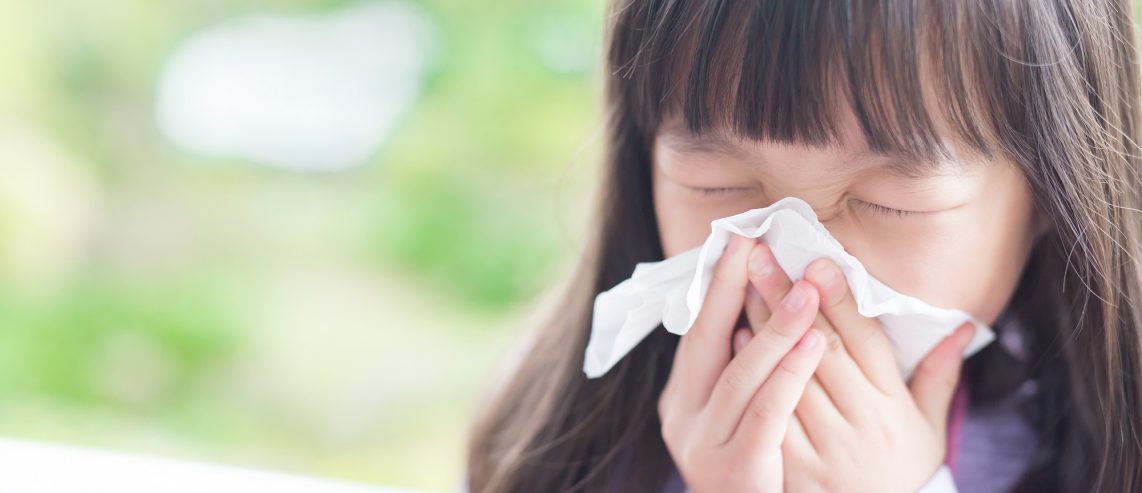You may chalk your kid’s sniffles, sneezes, or never-ending runny nose up to a simple cold. But if cold-like symptoms happen at about the same time each year, they may be due to seasonal allergies. Here’s what to know to tell whether your child has a cold or seasonal allergies.
What Are Seasonal Allergies?
Seasonal allergies are a type of allergic rhinitis. It’s when a trigger, called an allergen, irritates or inflames your nose or nasal passages.
The medical term for seasonal allergies is seasonal allergic rhinitis. It’s an allergic reaction mainly caused by pollen from trees, grasses, and weeds. Often found in leaf matter, outdoor mold can also trigger seasonal allergies.
Never Miss a Beat!
Subscribe to Our HealthBeat Newsletter!
Thank you for subscribing!
You can now select the specific newsletters you'd like to receive.
You are already subscribed.
Subscribe to more newsletters in our email preference center.
Sorry, an error occurred. Please try again later.
Get Healthy Tips Sent to Your Phone!
Can Kids Get Seasonal Allergies?
Seasonal allergies in kids are a common problem.
Nearly 1 in 5 kids have a seasonal allergy, according to the Centers for Disease Control and Prevention (CDC). They also note that boys are more likely to have seasonal allergies. About 20% of boys have seasonal allergies compared to less than 18% of girls, the CDC says.
Seasonal allergies run in families. So, if one or both of your child’s parents have seasonal allergies, your child is more likely to develop seasonal allergies.
If kids can get seasonal allergies, you may wonder: can babies have seasonal allergies?
Seasonal allergies often start in childhood and increase with age and more exposure to allergens. Some 10% of kids between 0 and 5 have seasonal allergies, according to the CDC. A toddler usually needs at least a couple of exposures to seasonal allergens to begin having seasonal allergies.
That said, younger kids can’t tell you how they’re feeling. So you have to look for symptoms and clues.
Signs of Seasonal Allergies in Kids
Colds can happen any time of year. Most cold symptoms last about a week to 10 days.
Your child may have a seasonal allergy if these two things are both true:
- They have ongoing and repeated cold-like symptoms that last more than a week.
- These symptoms happen at about the same time every year.
Symptoms of seasonal allergies
Typical seasonal allergy symptoms in kids include:
- Congested or stuffy nose.
- Itchy, red, runny, or watery eyes.
- Itchy nose or throat.
- Mouth breathing during sleep because of a stuffy nose.
- Runny nose.
- Sneezing or sniffling.
- Sore throat because of post-nasal drip in the back of the throat.
- Ear popping or infections caused by inflammation and fluid buildup.
Problems with Seasonal Allergies in Kids
Kids’ seasonal allergies are more than annoying. They can affect your child’s health and quality of life.
If your child has seasonal allergies, getting tested, reducing their risk, and getting treatment can make all the difference. Allergies, including seasonal allergies, are a big reason kids stay home from school each year.
If your child has asthma, seasonal allergies can make their asthma worse. According to the American Academy of Pediatrics, 80% of kids who have asthma also have allergies, including seasonal allergies. For these kids, allergens are the most common trigger of an asthma attack.
Testing for Seasonal Allergies in Kids
Your child’s doctor can help figure out if your child has seasonal allergies or something else. They may refer your child to an allergist, a doctor who is an expert in treating allergies. The allergist will decide which tests your child needs to find out if they have seasonal allergies.
To test for seasonal allergies, an allergist will:
- Take your child’s and family’s medical history.
- Give your child a physical exam.
- Do allergy sensitivity testing, including skin prick tests or blood tests.
Tips for Managing Kids’ Allergy Symptoms
You can’t prevent your child from developing seasonal allergies. But there are things you can do to reduce your child’s risk of seasonal allergens that trigger symptoms.
- Check pollen and mold forecasts online or on local news. Avoid or spend less time outdoors when pollen and mold levels are high.
- Teach kids to avoid touching their eyes when they are outdoors.
- Teach kids to wash their hands after being outside.
- Have kids take their shoes off before coming inside the home.
- Have kids change their clothes when they come home for the day.
- Have kids shower before bed to remove pollen from their skin and hair.
- Keep windows and doors closed during allergy season. Use air conditioning instead.
- Don’t hang clothes or bedding outside to dry.
- Limit contact with pets who spend time outdoors. Wipe down their fur when they come inside.
Treatments for Seasonal Allergies in Kids
If your child has mild symptoms, the tips above and simple saline nasal sprays may help relieve symptoms. Nasal sprays help to flush the pollen out of their nose.
Many seasonal allergy medicines for adults are safe and effective for kids. They take a different size dose, though. Talk to your doctor about how much allergy medicine to give your kids.
Treatment options will depend on your child’s allergy symptoms, medical history, and reaction to the medicine.
Allergy medicine for kids
Over-the-counter and prescription medicines include:
- Antihistamines to prevent and treat symptoms. These come in oral tablets, liquids, or nasal sprays.
- Corticosteroid nasal sprays to reduce swelling and inflammation in your nose. These help symptoms but don’t prevent the allergic reaction.
- Decongestants nasal sprays for quick symptom relief for less than three days in a row. Using these for longer can cause rebound congestion —the stuffy nose comes back, sometimes worse than before.
Check with your child’s doctor before giving them any medicine. If your pediatrician recommends allergy medicine, help your child take it safely by following these tips:
- Read and follow the medicine’s label.
- Give the dose your doctor suggests for your child’s age or weight.
- If your child takes other medicine, make sure the active ingredients aren’t the same. If they’re the same, it may cause you to give too much of the same treatment to your child. This can cause serious side effects.
Immunotherapy
If medicine doesn’t help your child or they have trouble taking it regularly, allergen immunotherapy may help. It involves getting doses of the allergen so that your body builds immunity.
Immunotherapy includes:
- Allergy shots. You can get these at an allergist’s office.
- Allergy tablets under the tongue (sublingual immunotherapy). The allergist will give the first few doses in their office.
Allergy medicine works best when you take it at least two weeks BEFORE allergy season begins. This helps prevent your child’s body from releasing histamine and other chemicals that cause seasonal allergy symptoms.
Different plants release their pollen at other times, causing pollen seasons. Pollen season and levels vary by where you live. Here are some pollen season examples:
- Tree pollen occurs from February through May. In some warmer climates, tree pollen may start as early as January.
- Grass pollen occurs from April through June.
- Weed pollen occurs from August through November.
Find out what plant is causing your child’s seasonal allergies, then look up when it releases pollen in your location. Use that timeline as a guide for starting treatment.
Sources
More Than a Quarter of U.S. Adults and Children Have at Least One Allergy. Centers for Disease Control and Prevention. National Center for Health Statistics. Link.
Diagnosing Allergies in Children. American College of Allergy, Asthma, and Immunology. Link.
Seasonal Allergies in Children. American Academy of Pediatrics. Healthychildren.org. Link.
9 Asthma Triggers and What to Do About Them. American Academy of Pediatrics. HealthyChildren.org. Link.
Hay Fever Triggers. Tips For Parents. American Academy of Pediatrics. HealthyChildren.org. Link.
Common Seasonal Allergy Triggers. American College of Allergy, Asthma, and Immunology. Link.
Pollen and Your Health. Centers for Disease Control and Prevention. Link.
Pollen Allergy. Asthma and Allergy Foundation of America. Link.
Nasal Allergies (Rhinitis). Asthma and Allergy Foundation of America. Link.
Allergy Relief for Your Child. Food and Drug Administration. Link.
Seasonal Allergies: Which Medication is Right for You? Food and Drug Administration. Link.
Flonase, Afrin, Nasacort, and More: What's the Best OTC Nasal Spray for Allergies? GoodRX. Link.
About UPMC
Headquartered in Pittsburgh, UPMC is a world-renowned health care provider and insurer. We operate 40 hospitals and 800 doctors’ offices and outpatient centers, with locations throughout Pennsylvania, Maryland, New York, West Virginia, and internationally. We employ 4,900 physicians, and we are leaders in clinical care, groundbreaking research, and treatment breakthroughs. U.S. News & World Report consistently ranks UPMC Presbyterian Shadyside as one of the nation’s best hospitals in many specialties and ranks UPMC Children’s Hospital of Pittsburgh on its Honor Roll of America’s Best Children’s Hospitals. We are dedicated to providing Life Changing Medicine to our communities.


